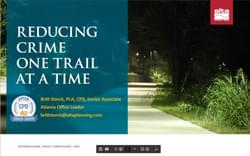Reducing Crime One Trail at a Time
Fighting crime through design.
by
Brittain Storck, PLA, CPD, Principal, Alta Planning + Design,
Jamie Rae Walker, Ph.D Texas A&M Extension,
Lisa Beyer, PLA Senior Associate, Alta Planning + Design
Crime Prevention Through Environmental Design is a proactive crime fighting technique in which the proper design and effective use of the built environment can lead to a reduction in the fear of and incidents of crime. Using a multi-disciplinary, multi-pronged approach to trail planning and design, law enforcement, landscape architects, city planners, and resident volunteers can create a climate of safety on trails.
View This Presentation Online

About the Authors

Brittain (Britt) Storck
has established her landscape architectural career around greenway and trail placemaking, natural resource-based recreation projects, and active community design and planning for 15 years. She co-chairs Alta’s National Trail Service Area, leads the firm’s east coast Landscape Architecture practice, and is a national expert on Crime Prevention Through Environmental Design (CPTED). Britt has worked collaboratively with engineers and planners, urban designers and in a volunteer capacity across the country to develop projects that activate communities and improve the quality of life. She has the CPTED Professional Designation (CPD) credentials obtained through the National Institute of Crime Prevention (NICP) training program. Individuals with this designation are qualified to identify strategies and concepts for projects that effect human behavior and influence a project’s real and perceived safety. CPTED experts perform field assessments and site plan reviews, write CPTED ordinances, author design guidelines, and provide overlay districts for planning and zoning.
Contact: [email protected]
Jamie Rae Walker is an Assistant Professor at Texas A&M Extension. Jamie Rae Walker, Ph.D. has worked in community planning and implementation for over 17 years. She provides community technical assistance in evidence based planning. She has presented and facilitated over 150 sessions. Jamie’s professional involvement includes TRAPS, Extension Specialist Association and recipient of Center for Disease Control grant projects for improving access to physical activity amenities. Jamie was honored with the TRAPS Educator Award, AgriLife Superior Service Team Award and USDA Team Awards.
Contact: [email protected]
Lisa Beyer is a landscape architect and urban designer, passionate about cities, design and community. Her love of urban landscapes informs a long-standing commitment to planning, design, and implementation of high-performance green infrastructure and public realm projects.
Lisa joined Alta Planning + Design in 2016 to help lead and grow the landscape design practice in Northern California. Alta is a leader in active transportation planning, design, and implementation, with expertise in trails, Complete Streets, parks and open spaces, wayfinding, and much more.
Prior to joining Alta, Lisa provided landscape and green infrastructure design and planning expertise as an on-site consultant to the San Francisco Public Utilities Commission. She was responsible for watershed-based planning, green infrastructure project design, program and policy development and outreach. Lisa served as lead landscape architect for Sunset Boulevard Greenway and Baker Beach Green Street projects. These early green infrastructure projects are the first landscape based stormwater management projects to be implemented by the City as part of the 6.9 billion Sewer System Improvement Program.
From 2008 to 2011, Lisa worked for the Philadelphia Water Department's Office of Watersheds in the Sustainable Stormwater Program. She was responsible for the planning, design and implementation of the landbased stormwater infrastructure programs outlined in Philadelphia's precedent-setting Green City, Clean Waters Plan. Lisa managed the development of the Green Public Open Space Program, the Maintenance Program, landscape design for Philadelphia Water Department (PWD) projects, project management, and policy development for green infrastructure implementation.
Contact: [email protected]
More articles by these authors
More articles in this category
Minimizing Risk and Liability
posted Aug 3, 2020
This document is a best practices manual intended to give guidance and direction on minimizing risk and liability for persons with an interest in operating and maintaining trails. Specifically, it seeks to help trail operators, managers and owners, mitigate risk and reduce liability, that can arise from trail design, trail use and maintenance operations. The techniques discussed here are intended to be applied with prudence and due consideration of the particular circumstances of each trail.
Greenways and Crime on Nearby Properties
posted Jan 30, 2020
This study investigates the question of whether the presence of a greenway increases the risk of crime occurring on the properties adjacent to the greenway.
942 views • posted 02/19/2018





